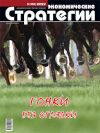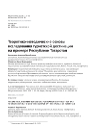Modeling Depopulation Trends in the Community of Countries with Different Economic Development Levels
DOI: https://doi.org/10.33917/es-3.183.2022.26-37
In this paper, an attempt is made to develop a mathematical model of population growth, based on socio-economic factors of the development of the countries’ community, as well as population migration. The author presents intermediate results of his review where he studies economic community, characterized by a very uneven development of regions. Mathematical model is proposed in which a conditional “center” and “periphery” (“global city” and “world village”) are distinguished. From the analysis of the existing socio-economic conditions of development it follows that “periphery” traditionally acts as a demographic donor for the “center”. Examples of such systems include, in particular, relations of the EU-Baltic republics, the EU-Ukraine, and Russia–EAEU countries. As an explanatory principle, it is proposed to use the concept of “institutional trap”. From the mathematical model point of view, this means rigidly fixed coefficients of connection between the system elements implementing one-way connection (toward the “center”). Possible mechanisms, influencing the dynamics of the system through adopting appropriate managerial decisions, are discussed. Obtained results prove the importance of adequate mathematical models for optimizing the strategic management of society.
Источники:
1. Ukaz Prezidenta RF ot 1 dekabrya 2016 g. N 642 “O Strategii nauchno-tekhnologicheskogo razvitiya Rossiiskoi Federatsii” [Executive Order of the President of the Russian Federation dated December 1, 2016 No. 642 “On the Strategy for Scientific and Technological Development of the Russian Federation”]. Ofitsial’nyi sait Prezidenta RF, available at: http://www.kremlin.ru/acts/bank/41449.
2. Complex Systems and Society — Modeling and Simulation. Springer, 2013, available at: https://link.springer.com/book/10.1007/978-1-4614-7242-1.
3. Solozhentsev E.D. Tsifrovoe upravlenie gosudarstvom i ekonomikoi [Digital Management of the State and Economy]. Upravlenie i planirovanie v ekonomike, 2018, no 1(17), pp. 136–153.
4. Federal’nyi zakon ot 28 iyunya 2014 g. N 172-FZ “O strategicheskom planirovanii v Rossiiskoi Federatsii” [Federal Law of June 28, 2014 No. 172-FZ “On Strategic Planning in the Russian Federation”]. Ofitsial’nyi sait Prezidenta RF, available at: http://www.kremlin.ru/acts/bank/38630.
5. Eberlin M. Foresight: How the Chemistry of Life Reveals Planning and Purpose. Discovery Institute, 2019.
6. Gaponenko N.V. Forsait. Teoriya. Metodologiya. Opyt [Foresight. Theory. Methodology. Experience]. Monografiya. Moscow, Yuniti — Danab, 2008, 239 p.
7. Unido Technology Foresight Manual. United Nations Industrial Development Organization, Vienna, 2005, vol. 1, p. 8.
8. Pereslegin S.B. Budushchee kak proekt: krizis futurologii [The Future as a Project: Crisis of Futurology]. Intellekt, voobrazhenie, intuitsiya: razmyshleniya o gorizontakh soznaniya (metafizicheskii i psikhologicheskii opyt). Saint-Petersburg, 2001, no 10.
9. Preobrazovanie nashego mira: Povestka dnya v oblasti ustoichivogo razvitiya na period do 2030 goda [Transforming Our World: The 2030 Agenda for Sustainable Development]. OON, 2017, available at: https://www.un.org/sustainabledevelopment/ru/about/development–agenda/
10. Madridskii mezhdunarodnyi plan deistvii po problemam stareniya 2002 goda [Madrid International Plan of Action on Aging 2002]. OON, 2002, available at: http://www.un.org/ru/documents/decl_conv/declarations/ageing_program.shtml.
11. Mikhailov A.P., Petrov A.P., Povedencheskie gipotezy i matematicheskoe modelirovanie v gumanitarnykh naukakh [Behavioral Hypotheses and Mathematical Modeling in Human Sciences]. Matematicheskoe modelirovanie, 2011, no 6, pp. 18–32.
12. Shumpeter I.A. Istoriya ekonomicheskogo analiza [History of Economic Analysis]. Vol. 1. Saint-Petersburg, Ekonomicheskaya shkola, 2001.
13. Clark G. Malthusian Economy. The New Palgrave Dictionary of Economics. Macmillan Publishers Ltd. London, Palgrave Macmillan UK, 2018, pp. 8148–8155.
14. Forrester J.W. World Dynamics. Wright-Allen Press, 1971.
15. Slovokhotov Yu.L. Fizika i sotsiofizika. Part 3. Kvazifizicheskoe modelirovanie v sotsiologii i politologii. Nekotorye metody lingvistiki, demografii, matematicheskoi istorii [Physics and Sociophysics. Part 3. Quasi-physical Modeling in Sociology and Political Science. Some Methods of Linguistics, Demography, Mathematical History]. Problemy upravleniya, 2012, no 3, pp. 2–34.
16. Uzawa H. Models of Growth. The New Palgrave Dictionary of Economics. Macmillan Publishers Ltd. London , Palgrave Macmillan UK, 2018, pp. 8885–8893.
17. Renshaw G. Maths for Economics. New York, Oxford University Press, 2005, pp. 516–526.
18. Spear S.E., Young W. Optimum savings and optimal growth: Ramsey — Mavlinvaud — Koopmans nexus. Macroeconomic Dynamics, 2014, vol. 18, N 1, pp. 215–243.
19. Romer P.M. Human Capital And Growth: Theory and Evidence. NBER Working paper. 1989, N 3173.
20. Kapitsa S.P. Global population blow-up and after. The demographic revolution and information society. Moscow, 2006.
21. Korotayev A., Malkov A., Khaltourina D. Introduction to Social Macrodynamics: Secular Cycles and Millennial Trends. Moscow: KomKniga/URSS, 2006.
22. Chernavskii D.S., Starkov N.I., Shcherbakov A.V. Estestvenno-nauchnaya kontseptsiya v ekonomike [Natural Science Concept in Economics]. Moscow, Grifon, 2016.
23. Zhulego V.G., Balyakin A.A. Chaos Modeling and Simulation (CMSIM) 3: “2–Phase Model for Population Growth”, 2015, pp. 193–204.
24. Korotayev A., Grinin L., Goldstone J. Great Divergence and Great Convergence. A Global Perspective. Springer, 2015.
25. Balyakin A.A., Zhulego V.G., Gadzhimuradov T.A. Podkhody k izucheniyu regional’nykh demograficheskikh trendov: riski i vyzovy dlya Rossii [Approaches to the Study of Regional Demographic Trends: Risks and Challenges for Russia]. Tsifrovizatsiya ekonomicheskikh sistem: teoriya i praktika [Digitization of Economic Systems: Theory and Practice]. Monografiya. Saint-Petersburg, Politekh-Press, 2020, pp. 341–364.
26. Balyakin A.A., Zhulego V.G. Geopoliticheskaya katastrofa — kak ona vyglyadit? [Geopolitical Catastrophe — What Does It Look Like?]. Bol’shaya Evraziya: razvitie, bezopasnost’, sotrudnichestvo: Ezhegodnik [Greater Eurasia: Development, Security, Cooperation: Yearbook]. M.: RAN. INION, 2021. S. 35–40.
27. Polterovich V.M. Institutsional’nye lovushki i ekonomicheskie reform [Institutional Traps and Economic Reforms]. Moscow, Rossiiskaya ekonomicheskaya shkola, 1998.
28. Saaty T.L. The Analytic Hierarchy and Analytic Network measurement processes: Applications to decisions under risk. European Journal of Pure and Applied Mathematics, 2008, vol. 1, N 1, pp. 122–196.
29. Turchin P. Complex Population Dynamics: a Theoretical. Empirical Synthesis. Princeton, NJ, Princeton University Press, 2003.
30. Nort D. Instituty, institutsional’nye izmeneniya i funktsionirovanie ekonomiki [Institutions, Institutional Change, and Economic Functioning]. Moscow, Fond ekonomicheskoi knigi “Nachala”, 1997.
31. Pol Devid. Klio i ekonomicheskaya teoriya QWERTY [Clio and the Economics of QWERTY]. Istoki: iz opyta izucheniya ekonomiki kak struktury i kak protsessa. Moscow, ID GU — VShE, 2007, vol. 6, pp. 139–150
32. Balyakin A.A., Taranenko S.B. Digital Economy as a Source of Revision of Basic Economic Concepts. Advances in Economics, Business and Management Research, vol. 156, Proceedings of the 2nd International Scientific and Practical Conference on Digital Economy (ISCDE 2020), pp. 689–694.
33. Keins D. Obshchaya teoriya zanyatosti i protsenta [General Theory of Employment and Interest]. Klassika ekonomicheskoi mysli: Soch. [Классика экономической мысли: Сочинения]. Moscow, EKSIMO-Press, 2000.
34. Marshall A. Printsipy ekonomicheskoi nauki [Principles of Economic Science]. Moscow, Progress, 1993.
35. Agalarov A.M.-Z., Balyakin A.A., Gadzhimuradov T.A., Zhulego V.G., Potapov A.A., Rassadin A.E. Dinamika pandemii COVID-19, lokal’nye i global’nye factory: Aktual’nye problemy matematiki i informatsionnykh tekhnologii: Materialy II Vserossiiskoi konferentsii s mezhdunarodnym uchastiem (g. Makhachkala, 5–7 fevralya 2021 g.) [Dynamics of the COVID-19 Pandemic, Local and Global Factors: Actual Problems of Mathematics and Information Technology: Proceedings of the II All-Russian Conference with International Participation (Makhachkala, February 5–7, 2021)]. Makhachkala, Izd-vo Dagestanskogo gos. un-ta, pp. 16–18.



